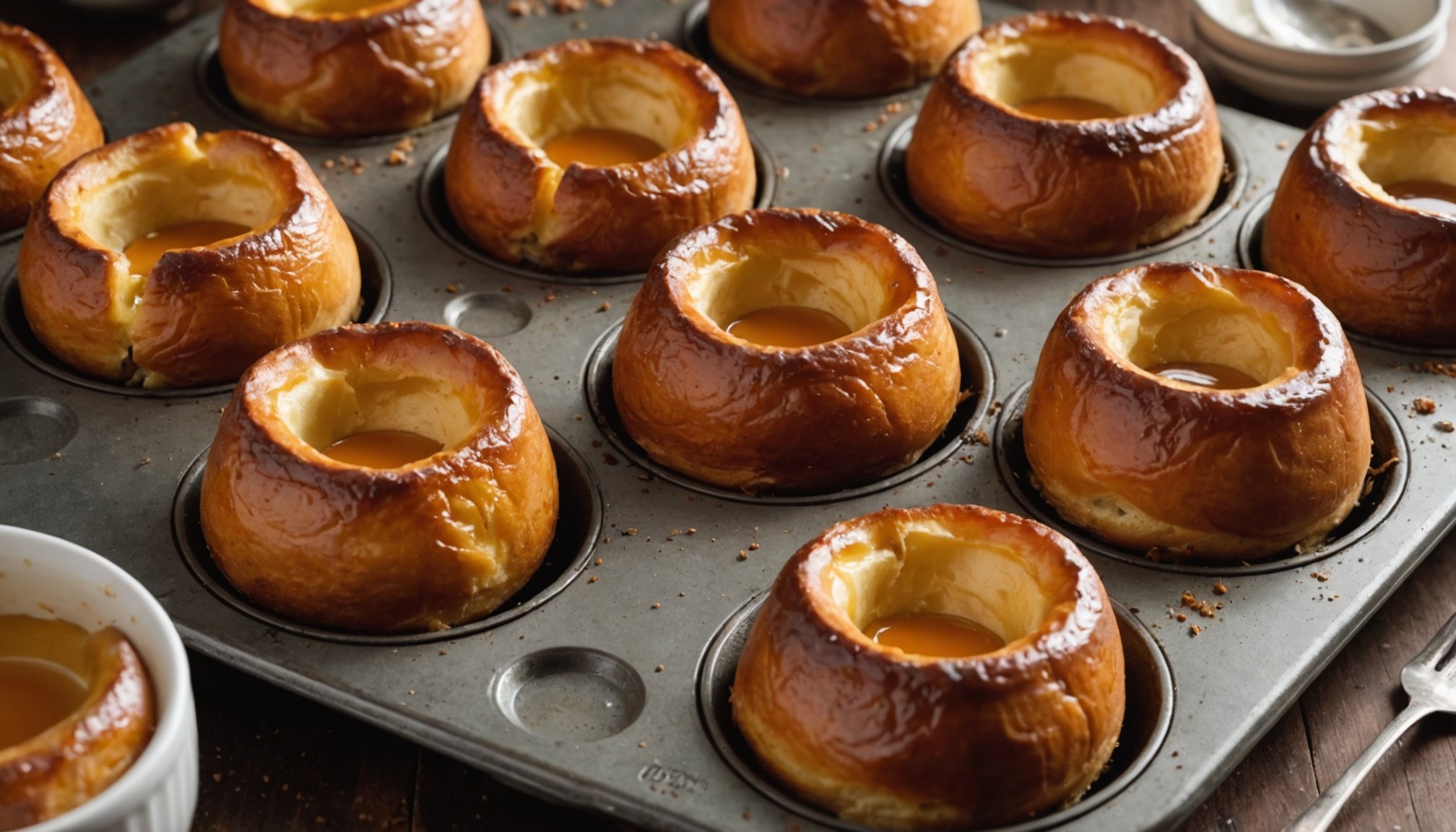Introduction to Yorkshire Puddings
Yorkshire puddings are a cherished element of British cuisine, celebrated for their light and airy texture. Originating from Northern England, this dish boasts a rich history dating back centuries, deeply intertwined with local traditions. The initial purpose of Yorkshire puddings was to absorb the juices of the roast, creating a savoury addition to the Sunday roast dinner.
Historically, they symbolised economy and resourcefulness, allowing households to stretch their meals further. The early recipes were basic, involving a batter made from flour, eggs, and milk, baked beneath a joint of meat where it would catch the drippings. This provided a tasty, filling component of a meal without wasting anything from the cooking process.
Topic to read : Unlock the Secrets to the Perfect English Pimm’s Cup: Expert Tips for Crafting the Ultimate Refreshing Beverage
Over the years, Yorkshire puddings have seen numerous variations and adaptations. While the traditional method remains popular, today’s cooks often experiment with sizes, from giant plate-sized puddings to smaller, bite-sized versions. Some add a twist by incorporating different herbs or spices into the batter, offering various flavours to this classic dish. These adaptations ensure that Yorkshire puddings continually evolve while retaining their fundamental essence as a staple of British culinary heritage.
Essential Ingredients for Fluffy Yorkshire Puddings
Creating the perfect Yorkshire pudding begins with selecting the right ingredients, ensuring each contributes ideally to its signature airy and crispy texture.
Also read : Mastering the Perfect English Custard Tart: Your Ultimate How-To Guide
Flour
The choice of flour is crucial for achieving fluffiness. Using plain flour provides the necessary structure while allowing the pudding to rise evenly. Its lower protein content prevents the batter from becoming dense, which is key to ensuring a light and airy final product.
Eggs
Eggs play a vital role in both the texture and flavour. They act as a binding agent and add richness, but most importantly, they trap air within the batter. This trapping process allows the pudding to puff up impressively as it bakes. To maximise this effect, ensure the eggs are at room temperature before mixing them into the batter.
Milk
The liquid component typically comprises milk, which helps achieve a smooth batter consistency. Whole milk works best as it provides the right balance of fat and fluidity, contributing to the pudding’s tender interior and crispy shell. For variations, you might explore different milk alternatives, yet whole milk remains the standard for traditional Yorkshire puddings.
Combining these ingredients with precision leads to delightful results, warming the heart and palate alike.
The Science of Fluffiness in Yorkshire Puddings
Achieving that coveted fluffiness in Yorkshire puddings hinges on both precise baking techniques and the effective use of leavening ingredients. One critical aspect is incorporating air into the batter. This process begins by whisking the batter vigorously, trapping air bubbles that will expand during baking, resulting in a high rise and airy texture.
Temperature plays a pivotal role as well. Preheating the oven and the muffin tins, or Yorkshire pudding tins, ensures the batter hits a hot surface immediately. This heat causes the trapped air to expand rapidly, contributing to a dramatic puff. The ideal oven temperature hovers around 220°C (428°F), creating the perfect environment for rise and structure.
Leavening agents complement this process. While traditional recipes rely on steam, modern adaptations might use baking powder for an additional lift. However, balancing this agent is crucial since excessive leavening can cause collapses. The interplay of air, heat, and leavening forms the scientific trifecta that crafts the ideal Yorkshire pudding. Understanding these principles allows aspiring chefs to refine their techniques and consistently produce light and perfectly risen puddings.
Step-by-Step Guide to Making Yorkshire Puddings
Crafting the perfect Yorkshire pudding requires careful attention to the cooking method and following a dedicated set of instructions. Here’s a section-by-section breakdown to guide you through the process:
Preparing the Batter
Begin by combining your designated ingredients: flour, room-temperature eggs, and whole milk. This mixture should be whisked vigorously to trap air, a crucial step for fluffiness. Aim for a smooth, lump-free consistency that will later expand dramatically in the oven.
Preheating the Oven and Pans
Set your oven to 220°C (428°F) and place your muffin tins or Yorkshire pudding tins inside to preheat for about 10 minutes. This ensures the batter immediately encounters a hot surface, promoting a quick rise.
Baking and Timing
Pour the prepared batter into the preheated tins, filling each about halfway. This allows space for the puddings to rise. Bake them for approximately 20-25 minutes without opening the oven door, as this can cause them to deflate. Look for a golden-brown exterior and impressive puff as indicators of doneness. Following these steps, you’ll achieve Yorkshire puddings that impress with their height and airy texture.
Utilizing Pan Drippings for Enhanced Flavor
Pan drippings are a treasured component of creating an extraordinary Yorkshire pudding experience, enhancing both flavour and texture. Capturing these drippings ensures that you incorporate the umami-rich essence of roasted meat into your batter, taking the pudding to new culinary heights.
To collect pan drippings, carefully pour the juices from the roasting pan into a heatproof bowl, allowing the fat to separate from any remaining meat juices. You can then spoon the fat into your pudding batter to provide that authentic savoury taste intrinsic to traditional recipes.
Integrating drippings requires careful balancing; too much may overwhelm the pudding, while too little may not fully enhance the flavour. Begin by adding a few tablespoons, adjusting as necessary for your personal taste preferences.
For serving, Yorkshire puddings enhanced with pan drippings pair exceptionally well with a classic roast beef dinner, especially when complemented by a rich gravy. Alternatively, use them as a flavourful base for dishes featuring roasted vegetables or stews. Embrace these serving suggestions to fully appreciate the enhanced depth that pan drippings bring, adding a delightful and unparalleled richness to this beloved dish.
Troubleshooting Common Yorkshire Pud Problems
Creating perfect Yorkshire puddings can be challenging. Identifying and resolving common issues—such as flat or soggy puddings—ensures consistent success. Soggy results often arise from not preheating the oven or tins adequately. Always ensure both reach the ideal temperature of 220°C (428°F) to facilitate immediate batter rise.
Improperly mixed batter can also cause flat outcomes. Gently whisk the ingredients to incorporate enough air without overmixing. This allows the puddings to puff up beautifully during baking. Precision in liquid proportions is crucial. An overly runny or thick batter can compromise the rise and texture.
If you encounter puddings that refuse to rise, examine the freshness of your ingredients, especially flour and eggs. Expired or improperly measured components can significantly hinder performance.
For persistent issues, consider experimenting with your cooking method. Switching to a fan-assisted oven can provide more even heat distribution, potentially solving deflation issues. By adjusting these elements and techniques, you’ll achieve Yorkshire puddings that are consistently delightful, with the perfect balance of crispiness and rise. Celebrate the small victories on your way to mastery.
Related Recipes and Variations
For those looking to explore beyond the traditional Yorkshire puddings, there are numerous creative variations and related recipes to consider. Experimenting with diverse meal ideas can lead to delightful adaptations.
One popular twist is incorporating seasonal ingredients, such as herbs or spices, into the batter. For example, adding rosemary or thyme can infuse the puddings with earthy flavours, perfect for autumn. Alternatively, cheese lovers might enjoy a sprinkle of grated cheddar for a savoury touch, creating a delicious pairing with soups or stews.
For a more substantial variation, consider creating filled Yorkshire puddings. These can be used as edible bowls, holding hearty fillings like beef stew or mushroom ragout, making it a complete meal. This approach not only adds variety but also elevates the traditional snack into a main dish.
Pairing Yorkshire puddings with complementary dishes can further enhance the dining experience. They pair beautifully with classic British fare such as roast dinners, and they can also accompany international-inspired dishes, like curries or chilli, offering a cross-cultural culinary experience.
Exploring these related recipes and variations can bring exciting new dimensions to the beloved Yorkshire pudding, inviting further culinary creativity.





